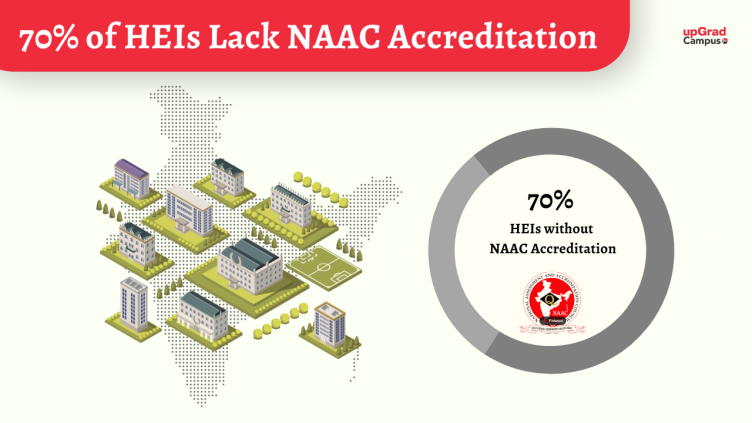More Than 70% of HEIs Lack NAAC Accreditation. Here’s Why.
On February 27, 2023
Just about 9,000 of the approximately 45,000 HEIs in the nation have received accreditation from NAAC
National Assessment and Accreditation Council (NAAC) accreditation is an essential body of the Indian Higher Education system. It serves as a quality assurance mechanism in Higher Education Institutions (HEIs) and enables them to benchmark their performance against other institutions. NAAC has been established by the University Grants Commission (UGC) to assess and accredit HEIs based on several parameters, including curriculum design, faculty quality, infrastructure, research, and community engagement.
NAAC Accreditation Status in India
Despite the importance of NAAC accreditation, many HEIs in India lack this recognition. The official report of the UGC indicates that there are around 45,000 HEIs in the country, and NAAC has accredited around 9,000 of them; that translates to a whopping 80% of HEIs running without proper accreditation. Out of the remaining 36,000 HEIs, all may not be eligible for accreditation as it requires a minimum of 6 years of existence or two batches of pass-outs to be suitable for assessment.
The Need for NAAC Accreditation
NAAC accreditation is crucial for HEIs in India as it helps them to gain recognition and secure funding from the UGC. It is also instrumental in attracting students and faculty, improving the quality of education, and building an institution's reputation. Accreditation is seen as a mark of quality, and it indicates that an institution has met specific standards set by an independent body.
Reasons for Lack of NAAC Accreditation
1. Insufficient Resources
One of the primary reasons for HEIs lacking NAAC accreditation is the lack of resources. The accreditation process is time-consuming and expensive, and many institutions may not have the necessary funds or staff to meet the requirements. The method of accreditation involves self-assessment, peer assessment, and assessment by NAAC. It also requires institutions to maintain specific standards in terms of infrastructure, faculty, and curriculum.
2. Faculty Shortage and Quality
The quality of faculty is one of the essential factors that NAAC assesses. Institutions are expected to have a sufficient number of qualified and experienced faculty members to teach students. However, many HEIs in India suffer from a shortage of qualified faculty. This is due to various reasons, such as a lack of funding, insufficient incentives, and low salaries. The faculty shortage affects the quality of education and research in the institution, making it challenging to meet NAAC's standards.
3. Inadequate Infrastructure
Infrastructure is another critical aspect of NAAC accreditation. The infrastructure of an institution includes the physical facilities, equipment, and technology available to students and faculty. The institution is expected to provide adequate facilities for teaching, learning, research, and other academic activities. However, many HEIs in India suffer from inadequate infrastructure due to insufficient funding and resources.
4. Limited Research and Innovation
NAAC also assesses an institution's research and innovation capabilities. HEIs are expected to have a robust research culture and encourage innovation among faculty and students. However, many HEIs in India lack a strong research culture, and there is limited emphasis on innovation. This is due to various reasons, including a lack of funding, inadequate research infrastructure, and insufficient incentives for faculty and students.
5. Low Student Enrolment
The number of students enrolled in an institution also plays a crucial role in NAAC accreditation. Institutions are expected to have a sufficient number of students to maintain academic vibrancy and diversity. However, many HEIs in India suffer from low student enrolment due to a lack of reputation, inadequate facilities and lack of good placements.
upGrad Campus Can Help Improve an HEI's NAAC Ratings
Our flagship product, the Blended Learning Solution, uses the Lecture Capture System. This automated tool enables automatic audio and video recording and distribution of classroom lectures, enhancing students' overall learning experience. It enables educational institutions to ‘upGrade’ conventional classrooms into a hybrid learning ecosystem and, thus, enables them to get better NAAC ratings as criteria 4.3 of the NAAC Accreditation talks specifically about the ICT Enabled Classrooms.
In addition, upGrad Campus also offers content solutions that improve the Curriculum by incorporating New-age Specializations, as well as enhancing Collaboration by bringing Industry Experts to teach. This approach ensures that students receive a comprehensive and practical education that prepares them for the job market.
[Dear readers, if you are part of a Higher Education Institution and looking to transform your College/University, you can reach out to us at campus.sales@upgrad.com or drop us a “Hi” on WhatsApp.]


